Disclosure: Meeple Mountain received a free copy of this product in exchange for an honest, unbiased review. This review is not intended to be an endorsement.
[April 12th, 2051]:
Shhhhhhwwoooooooooosh! An alien craft soars through the air, its metal carapace bristling with weapons of unimaginable destruction. Thuuuuuuump-whump-whump-whump! Ceaseless anti-air batteries release volley after volley after volley at the encroaching enemies. Ptschk-ptschk-ptschk-zzzzzzzzzz! A generator crackles and shudders as its reserves are drained to maintain the complex defense systems. Skreeeeeeee-boom! One of the ships crashes to earth amid a chorus of exhausted cheers. Still the fight rages on.
Hope is running low. Our little bunker is outnumbered, outgunned and outclassed. Each ship we shoot down is replaced a moment later. Soon the strange monsters inside those ships will be here and they are not gonna play nice. There’s one chance left, the last gasp of a city on the brink of destruction: if we can just hold them at bay long enough, we can complete our research. It won’t help us. We know that. But it may be the stone that stems the tide of this invasion, that saves the human race even at the cost of so many individual human lives. We turn the generators to max, pull every available hand away from defense and down to the laboratory, and steel ourselves for the dark moments to come. That’s when we first see the Mothership looming overhead…
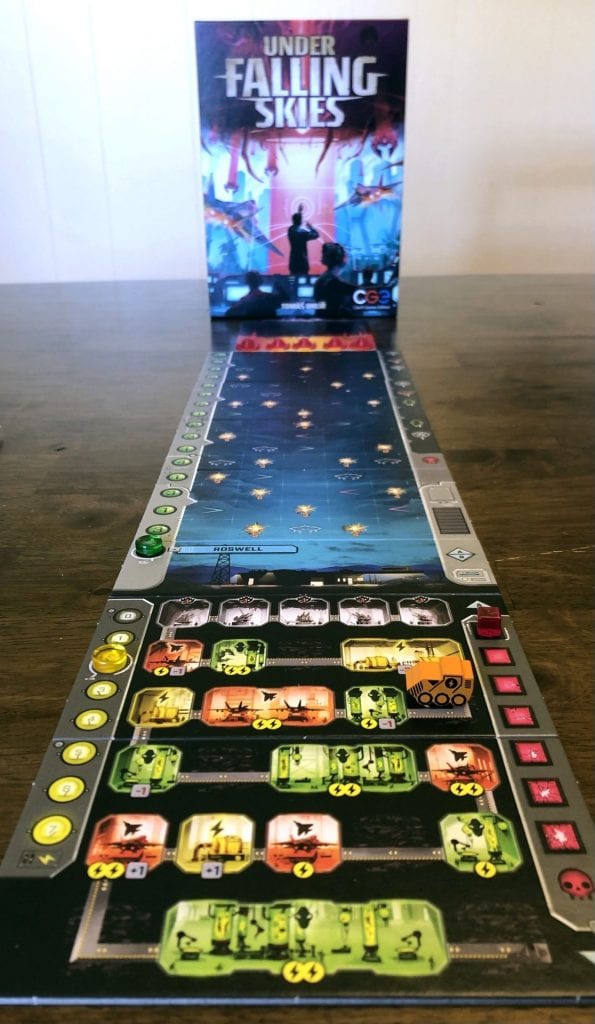
The Day the Earth Stood Still
Okay: the sound effects are a little much, but it’s hard not to get into the spirit of Under Falling Skies from Czech Games Edition. This tight and clever dice-management game drops a single player into the fight of their lives, pitting them against an endless horde of enemy invaders in a tense duel to determine the fate of planet Earth. If that isn’t worth a few shwooshes I don’t know what is.
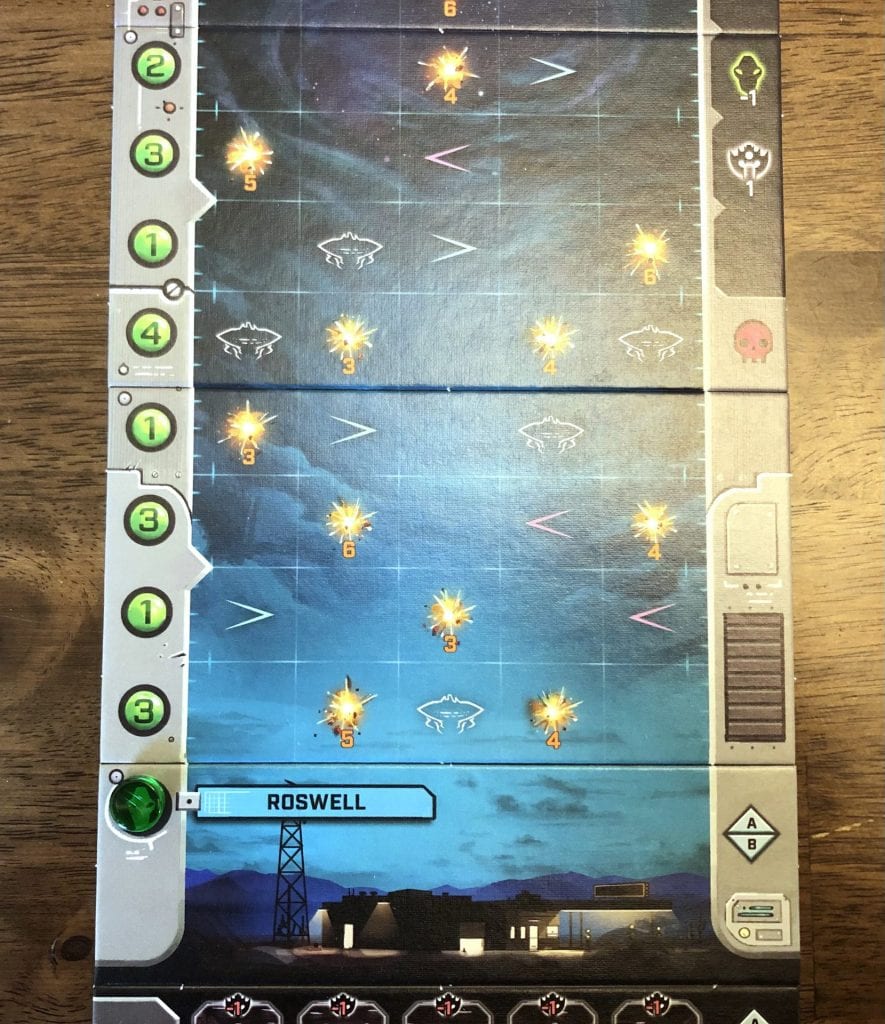
Adapted from a 9-card microgame, the boxed retail edition of Under Falling Skies is easy to set up and play. Each game requires the player to lay out a few modular boards, a handful of dice and several bits. Four of those boards create the airspace above Earth. Three more are placed to create the city under attack — one for the city itself with its unique special ability and two for the vast bunker hidden below it. The bunker is composed of five columns of rooms connected by tunnels; each room has a function (for example, shooting down enemy ships) and generally includes a power cost or a modifier that helps determine how effective it is each round. The tokens track things like energy and the integrity of the city (health).
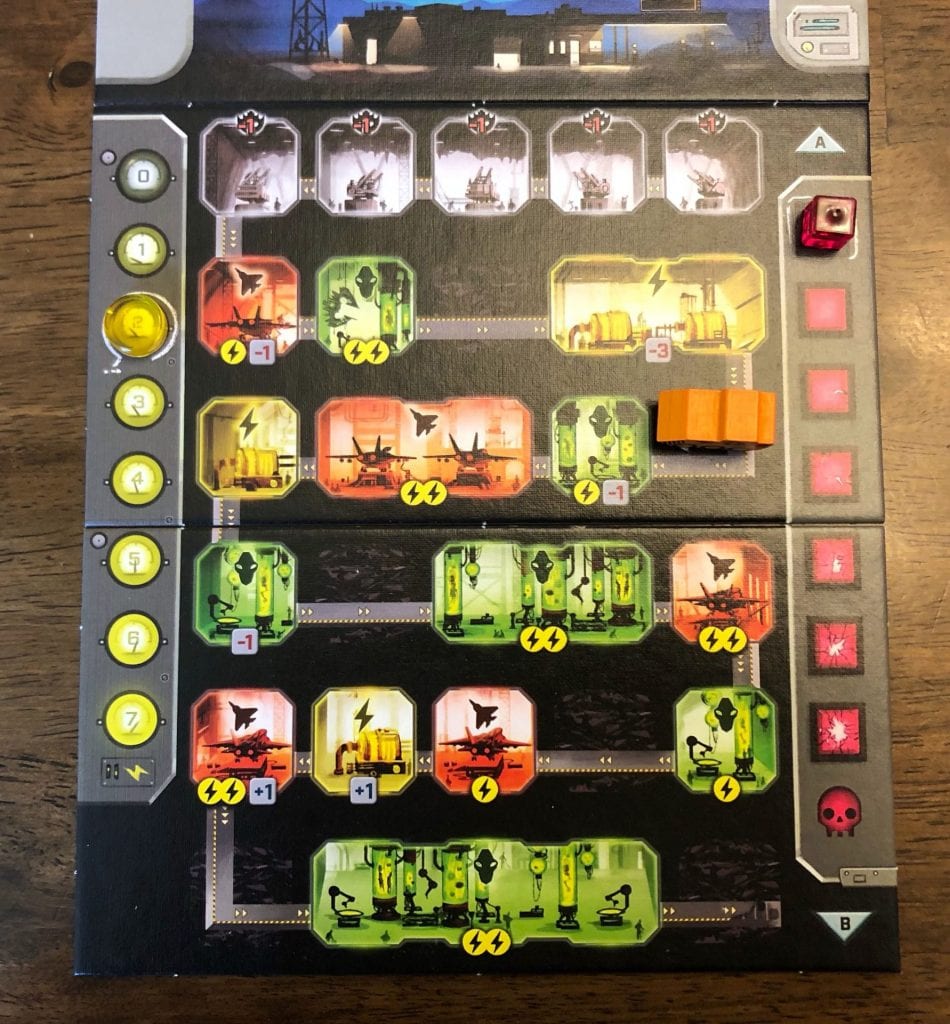
Each round the player will grab five worker dice — two white and three grey — and roll them, then begin assigning each die to a room in the bunker. Once all dice are placed, rooms are resolved in any order the player chooses.
There are a few rules about placing worker dice. First, there can only be one die per space (no stacking dice on top of each other) and one die per column, of which there are five. Secondly, whenever a white die is placed, all remaining dice are immediately rerolled; since there are two white dice, this means that there will always be at least one mandatory reroll and possibly two. Lastly, whenever a die is placed in a column, all enemy ships in that column move down a number of spaces equal to the die’s value.
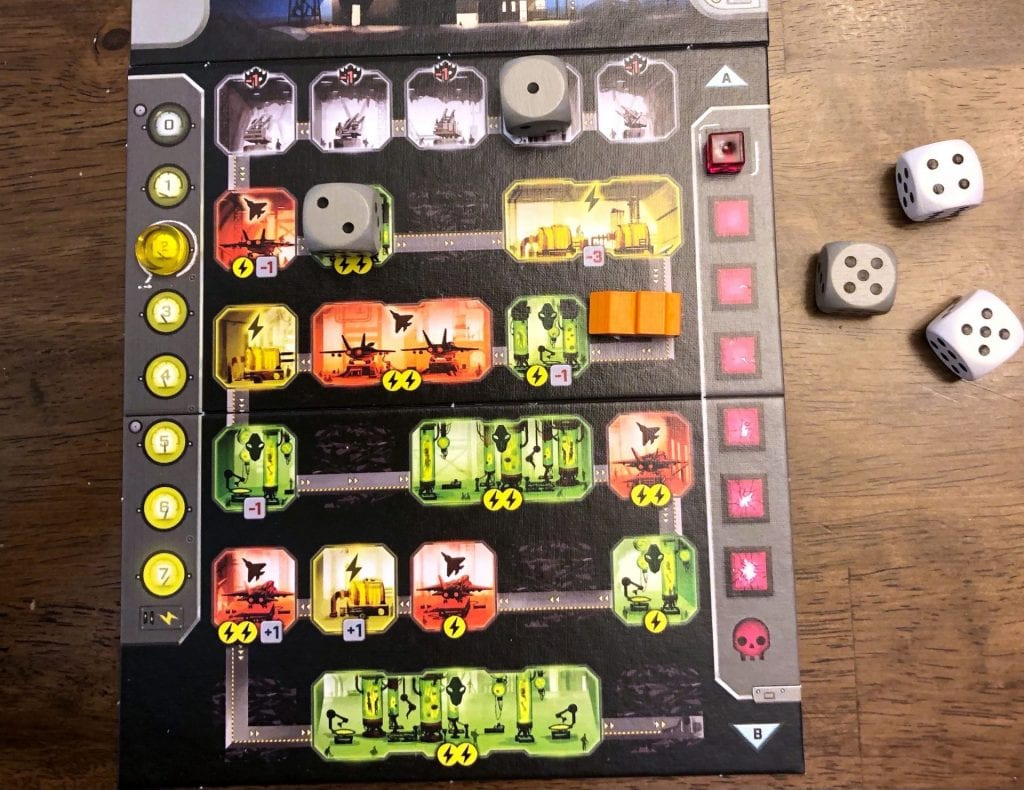
What, you forgot about the alien invaders laser-focused on conquering Earth? Well, you’ll be thinking about them plenty from here on out. At the start of the game the alien Mothership is placed above the modular sky boards and a single smaller ship will be placed in each column. As dice are placed the small ships will advance down the rows of their column; at the end of a round the Mothership will also move down one row. If a ship reaches the top of the city, it does a point of damage. Take too many hits and the bunker is lost.
Each column has a few spaces with special rules if a ship lands on it — for example, it might shunt a ship to a neighboring column or advance the Mothership a row immediately. The Mothership also has a special symbol in each row and the effects of these are much worse: many set the player’s progress back or add additional enemy ships to the board. The final symbol that the Mothership can trigger is a big red skull. If the Mothership hits that… it’s game over, man, game over.
Subterranean Homesick Blues
To defeat the enemy, the player must make clever use of the bunker’s various rooms. Each of these rooms works a little differently but broadly speaking a room is as effective as the die value placed into it, plus or minus any listed modifiers. Power generators, for example, will generate that much energy. Energy is crucial for powering some of the more advanced rooms.
Energy also powers the excavator. Some rooms are not available at the start of the game and must be dug out in order to be used. The excavator allows the player to place a die in a room or tunnel not yet accessible; at the end of the round the excavator bulldozes up to that spot and everything it unearths is now available to the player.
Of all the rooms, the most important are the laboratories. Running all the way up the left side of the modular boards is a research track with various numbers. To win the game, the player must advance to the top of the track by placing worker dice in the bunker’s labs. Naturally, this means that fewer dice can be placed for power generation, excavation, defense, or anything else the player might want to do.
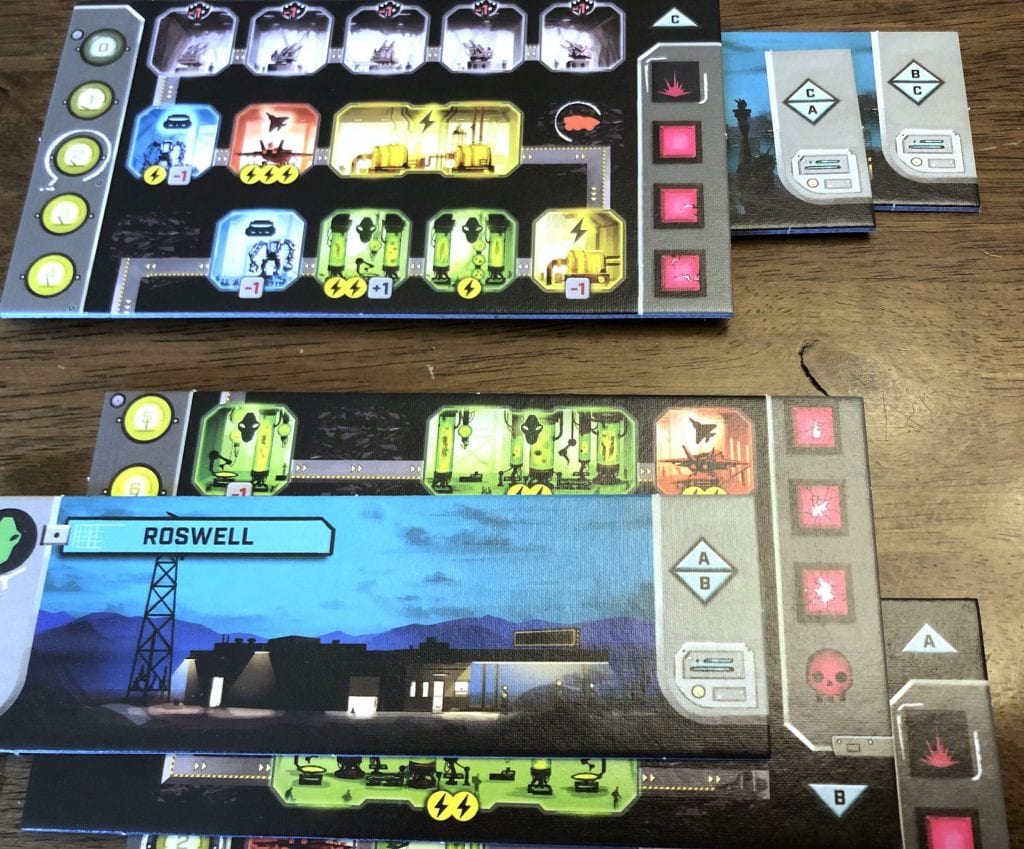
And herein lies the heart of the game: everything, every single choice that the player can make, requires a significant trade-off. Place a die in a power generator and it prevents the use of the anti-air batteries above it. Spend energy on the excavator to access more rooms and that energy won’t be around next turn to power the newly-uncovered lab. Sneaking a small die into a room might minimize enemy encroachment but it makes the room’s effect minimal as well. Investing a large die means more bang for the buck yet it also means the enemy ships fly toward the city with otherworldly speed.
Nowhere is this tension more clear than in the white die’s reroll mechanic. The mandatory reroll, triggered by placing either of the white dice, can be a player’s saving grace when it lets them roll away some unhelpful values. It can also be their worst nightmare if the round depends on placing a white die before a specific grey one. Every round is a harsh lesson in timing and the danger of pushing one’s luck too far.
One of the best things about Under Falling Skies is its flexible difficulty level. Players can increase or decrease the difficulty by using the basic or advanced sides of the sky boards. I’ll freely admit that I’m not an expert, so the normal difficulty (1 advanced sky board) was perfect for me. Most of my games still ended in a loss but none of them felt out of reach. Far more frequently I’d find myself trying to steal victory from the jaws of defeat in the final turn, only a few bad rolls or a couple early mistakes away from the win.
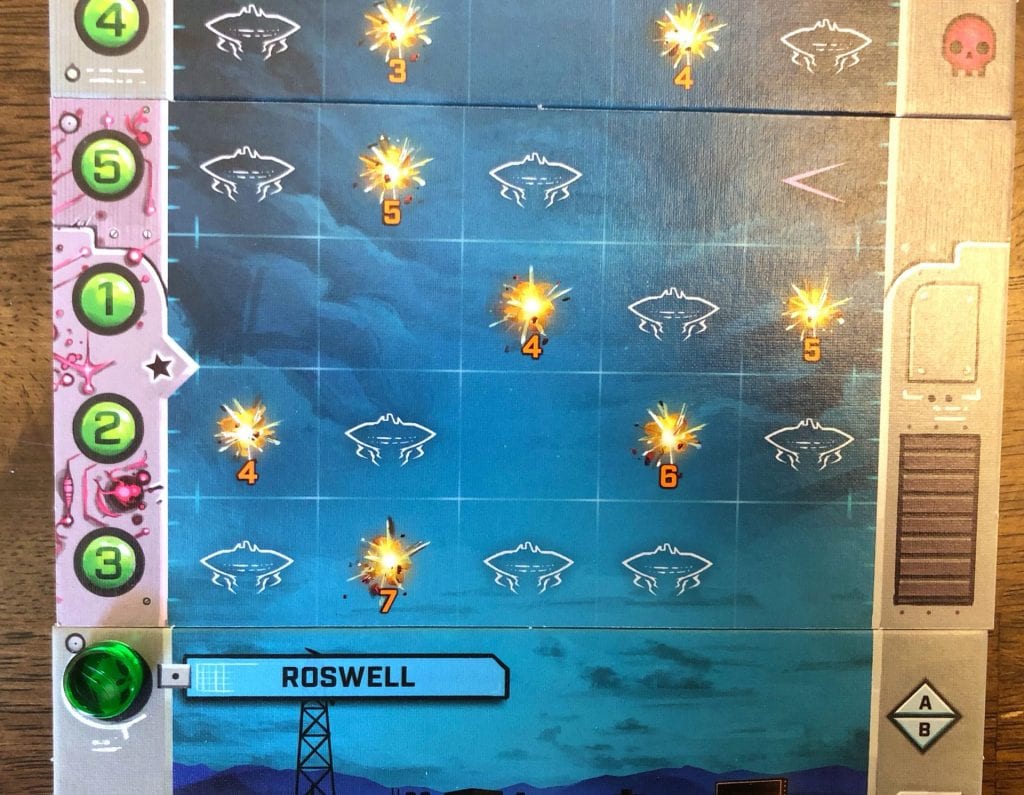
While the base game is fantastic at keeping the screws turning every moment, Under Falling Skies comes boxed with a campaign mode as well. Discussing the campaign will risk a few minor spoilers, so you can click on the link below to learn more or skip ahead for my spoiler-free final thoughts.
Kick the Tires and Light the Fires
After getting the hang of the core gameplay, players can crack open the first of 4 campaign chapters to start testing their skills against a full-on global assault. Each chapter bundle includes unique scenarios, double-sided characters, and city and bunker boards as well as a handful of new bits to play with. The campaign is completely replayable; players will use only a few of the parts included in each bundle, so there will be plenty of surprises and different combinations the next time through.
To get started, the player will divide each bundle into 4 piles featuring a scenario, a character, and a city board. They will then select 2 of those piles, look them over, and pick the one they want to play. The other one is set aside for the remainder of the campaign. Each chosen mission is played at most twice: if the player wins the first time through, they may immediately proceed to the next; if they lose, they flip the city board to its “damaged” side and play again, proceeding either way once the mission is over. The player will then choose 1 of the 2 remaining piles and play that combination once or twice before moving on to the next chapter.
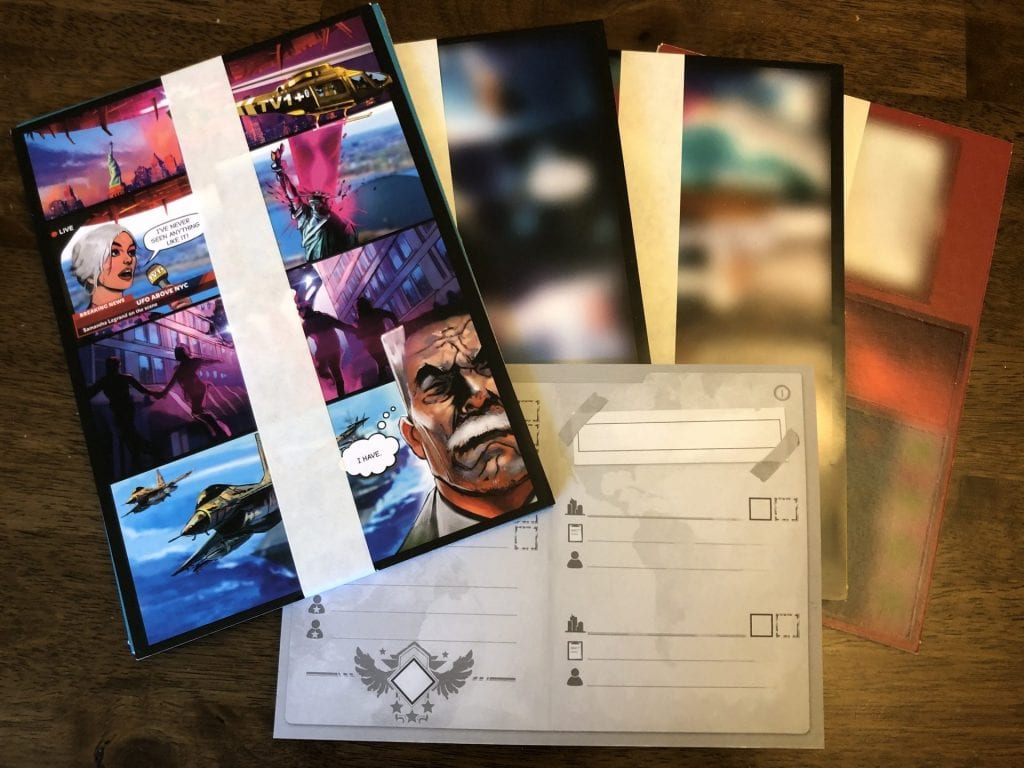
Without spoiling too much, let me say that the campaign is absolutely phenomenal. Some of the characters, cities, and scenarios that come up are fantastically clever, twisting the game in unexpected directions. What’s really impressive is how lean the campaign is compared to the experience it provides. No mountains of plastic bits here: the campaign for Under Falling Skies uses only a few sheets of cardboard, finding ways to use and reuse those components in excellent ways that feel all the more satisfying for their efficiency.
Life During Wartime
While I’d love to say that I single-handedly saved the Earth, nothing could be further than the truth. Early losses showed the invaders that the commander in charge was unprepared to lead and the alien menace pressed that point home by laying waste to humanity across every corner of the globe. No two cities were not on fire.
Yet because of the theme and the almost cinematic way that the campaign builds — again, an impressive feat considering how little flavor text there is — I desperately wanted to win. As games began to slip through my fingers I tried even harder, combing through each available component for clues that would help me defeat the invaders, thinking through each placed worker die as though it was a real human being. Who but Six — hard-working Six! — could be trusted to run the generators?
When a game evokes that kind of genuine feeling from me, I know it’s a masterpiece.
It Came From Outer Space
I’m not one to say that any game is perfect. Even my favorite games have flaws. Production and publishing are difficult processes, so there’s always something that turns out poorly. Games also depend on the players: their expectations, their interactions, their interpretations, their mood.
Under Falling Skies might just be a perfect game.
There’s absolutely nothing at all I dislike about it. The rulebook is clean, the graphic design is clear, the components are sparing yet effective, the gameplay is elegant and balanced. A huge amount of thought went into this game and it shows. From every angle Under Falling Skies is a fantastic game, full-stop.
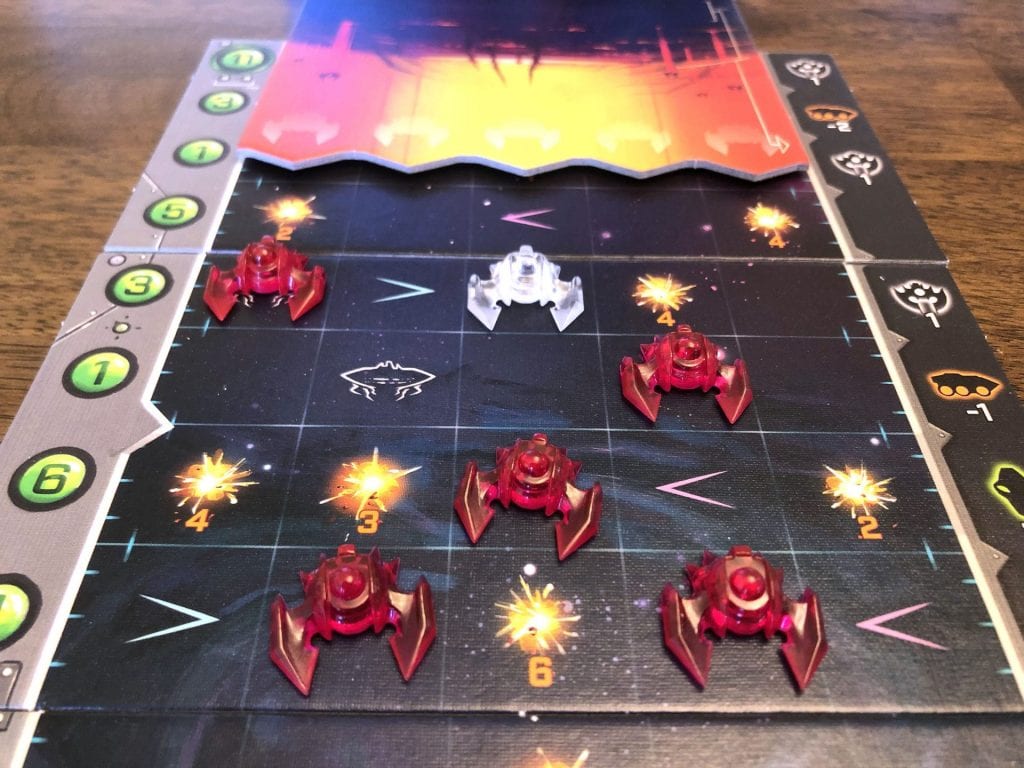
But what I really love most about it is that every moment of it belongs to me. I don’t just mean that it’s a solo game — there are plenty of solo games that don’t feel this personal. It’s that every choice is in my hands from the first turn to the last. I choose the difficulty, I choose the city under attack, I choose what I do and even what the enemy does in response. I choose when to push and when to pull back and I alone bear the gravity of those decisions when they are wrong.
If the most important aspect of a game is that it facilitates interesting and meaningful decisions, then Under Falling Skies truly is a perfect game. It’s nothing but interesting decisions. The fact that it has fantastic table presence and a killer theme is just a bonus.
This game is mine. Now go find a copy of Under Falling Skies and make it yours.


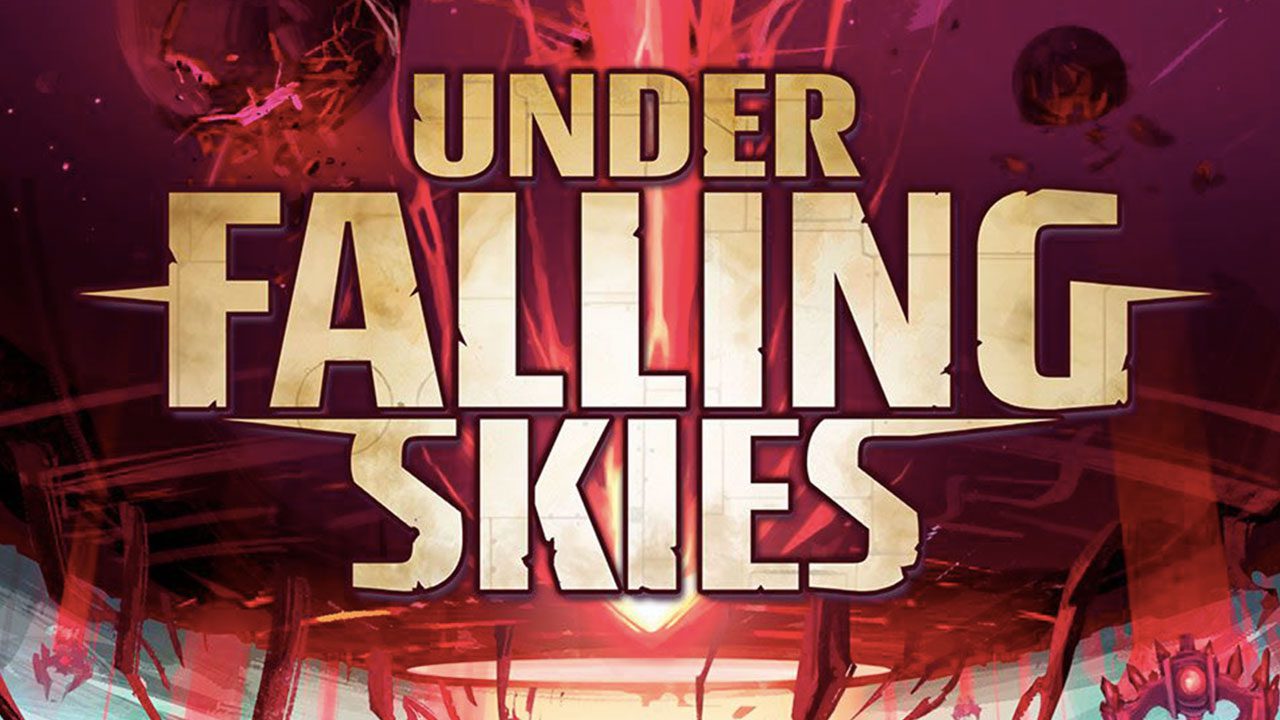

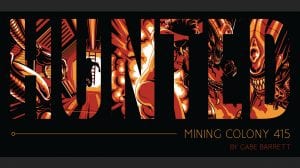






I have the PnP version; and I love it. I will have to consider getting the professionally printed version as well. 🙂
Informative blog. Thanks for sharing your views. I was doubtful whether to buy or not. However, I have now made up my mind to buy it.
That’s great Prasanti, enjoy!
Wow, this was the last solo review for a board game that you did? This is dated April 12, 2021. We are now practically 1 year since you’ve done any solo game reviews. Yet, I see that you guys are very current on non-solo board game reviews in general. Why is this? Not doing enough solo board game reviews tells me that you’re not really into games with solo modes, which is a shame.
Mainly it’s because we only have 1 or 2 people who lean towards solo gaming. And even those people also enjoy gaming with partners. Plus this is an all-volunteer site so people write what they want. We’ll have more solo coverage at some point, sorry we don’t have anything more recent for you.
Hi! Thank you for asking about solo game coverage. As a dedicated solo gamer, I’m just as passionate about seeing reviews for solo games as you are. While we can’t guarantee that all games will receive coverage of solo play, we do our best to include coverage when we’re able. However, it appears that some of those reviews have not been indexed correctly, making it difficult to see them all together. We’ll be updating our articles over the next few weeks to help make it easier to find that content. In the meantime, I recommend checking out our Solo Gaming Archives, which should now display a few of our more recent reviews of solo games. Thank you for the question, and we hope you’ll keep an eye on Meeple Mountain for our upcoming solo reviews!
https://www.meeplemountain.com/tag/solo-gaming/